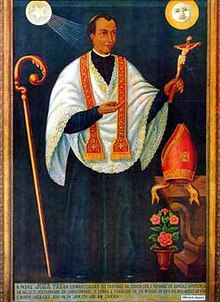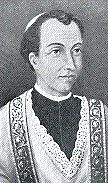Joseph Vaz
Joseph Vaz ( English : Saint Joseph Vaz ; Konkani : Bhagivont Zuze Vaz ; Portuguese language : São José Vaz ; Sinhala : ශාන්ත ජුසේ වාස් පියතුමා Santha Juse Vaz Piyathuma ; Tamil : புனித ஜோசப் வாஸ்; * April 21, 1651 in Benaulim , Taluk of Salcete , India ; † January 16, 1711 in Kandy , Sri Lanka ) was a Catholic priest from India and one of the main missionaries of Sri Lanka. He is a saint of the Catholic Church and is called the Apostle of Ceylon .
Live and act
In India
Joseph Vaz was the third of six children of the Indian married couple Christoph Vaz (from Sancoale) and Maria de Miranda (from Benaulim). His family originally belonged to the Brahmin caste , but had become Catholic and adopted the Portuguese surname Vaz. The boy learned Portuguese in Sancoale and Latin in Benaulim. His father sent him to Goa , where he completed his studies at the Jesuit College St. Paul and the Dominican College St. Thomas Aquinas. In 1675 he became a deacon, and in 1676 he was ordained a priest from Archbishop António Brandão of Goa. Joseph Vaz was a great admirer of Mary, which is why he liked to refer to himself as "Servant of the Virgin Mary" . He quickly became known as a good preacher and confessor in his homeland.
Vaz asked the episcopal authority to send him to the mission. Instead, he was entrusted with the thankless task of a vicar general in southern Kanara , with the capital Mangalore . At that time there was a competing Catholic jurisdiction that later led to the Goanese Schism . On the one hand, the area had belonged to the Archdiocese of Goa or its suffragandiocese Angamaly since ancient times , on the other hand the Pope had appointed a Vicar Apostolic there named Thomas de Castro and the territories were later attached to the Vicariate Apostolic of Malabar and Verapoly for administration, as the Portuguese colonial rulers joined the west coast of India had meanwhile been ousted by the Dutch and the latter did not tolerate any Portuguese-dependent bishops in their areas. Regardless of the practical competence of the Vicar Apostolic, the Portuguese insisted on their historical rights, which led to constant internal church tensions and to great annoyance. The Goanese bishops could not administer their dioceses personally and only supply them in a particular way - mostly through agents. However, they clung to the historical jurisdictions with great tenacity. As soon as they were able to reach one or the other parish again due to changing political circumstances, they immediately took possession of them and drove out the officials of the opposite side. Sometimes the jurisdictions of individual municipalities changed several times within a few years. One of these agents of the Portuguese Archbishop of Goa was now Joseph Vaz. He should assert his rights there and represent him.
In 1681 Joseph Vaz met the Vicar Apostolic Thomas de Castro in Bangalore . The latter explained the situation to him in detail and convinced Vaz of the papal confirmation of his office. Instead of sticking to the Goanese counter-position, Vaz submitted to the Vicar Apostolic, subject to a final decision from Rome. He was now entrusted by him with the same office that he had been given in Goa and was thus able to do missionary work in the area undisturbed, representing both competing jurisdictions at the same time, so to speak.
When the Goanese Archbishop Manuel de Sousa e Menezes learned of the agreement between Vaz and the Vicar Apostolic de Castro, he was very dissatisfied and reproached the priest persistently. At his own request, Vaz was finally relieved of his post in South India in 1684 and returned to Goa; in spite of his only relatively short stay there he was generally held in high esteem as a pious and peace-loving mission priest. He had also founded several churches or had them rebuilt or rebuilt, the most famous of which is the Mangalore Rosary Cathedral .
In 1685 Joseph Vaz joined the order of the Oratorians in Goa and soon became their local superior.
Apostle of Ceylon
When Joseph Vaz learned of the sad fate of the Catholics in Ceylon, who were strongly oppressed by the Dutch, who also did not admit any clergy, he decided to go there. There were also large areas here where Christianity was not yet widespread. In 1686 he received permission to begin his mission and in 1687 came by ship from Kollam via Tuticorin to Sri Lanka.
The priest ended up in Jaffna , but could only work there in secret and had to constantly fear the reprisals of the Dutch. In 1691 he therefore moved to the Buddhist Kingdom of Kandy . Here he was imprisoned together with two other co-religionists as a supposed Portuguese spy and thus had the leisure to learn the local Sinhala language . When there was a great drought and the Buddhist priests were unable to remedy the situation, King Vimaladharmasurya II turned to Father Vaz. He erected an altar with a cross and pleaded for rain, which set in shortly afterwards. As a result, he was released and he now evangelized from Kandy in the Dutch area around Colombo . His selfless commitment to a smallpox epidemic even gave Joseph Vaz permission to do missionary work in the Kingdom of Kandy. Archbishop Pedro Pacheco of Cochin , Suffragan of Goa, had officially appointed him his vicar general in Ceylon. Together with other priests of his order who came from India, Vaz developed an active missionary work, both in the territories under Dutch colonial sovereignty and in the areas of local princes. He also translated several religious works into Sinhala.
King Vimaladharmasurya II died in 1707, his successor King Vira Narendra Sinha also supported Joseph Vaz and his confreres. Father Joseph Vaz died in 1711 at the age of 59 in Kandy, with a general reputation for miracles and holiness. He was buried in Kandy at the request of the king; later, however, all sites of Christianity were destroyed here, which is why the grave of Joseph Vaz is now lost.
Bishop Francisco de Vasconcellos SJ of Cochin initiated the beatification process for Joseph Vaz as early as 1737 , which however, due to the circumstances of the time, did not come to a conclusion for a long time and was finally forgotten. The Apostolic Delegate of the East Indies, Ladislaus Zaleski (1852–1925), who resided in Kandy , kept hearing reports from this priest, who had died in the name of holiness. He did his own research on him, became a great admirer of Joseph Vaz and published a multi-edition biography about him. Thereupon the beatification process was resumed and in 1953 the Archdiocese of Goa and Daman concluded with a positive result. On January 21, 1995 Joseph Vaz was beatified by Pope John Paul II in Colombo; his liturgical feast day is January 17th.
On January 14, 2015, Pope Francis Vaz canonized in Colombo on the occasion of his pastoral trip to Sri Lanka.
literature
- Ladislaus Zaleski : "The apostle of Ceylon, Father Joseph Vaz, 1651-1711" , Benziger Verlag, Einsiedeln, 1911
- Anton Huonder SJ: "Bannerträger des Kreuzes" , Herder Verlag, Freiburg, 1915
- Ulrich van der Heyden, Heike Liebau: "Mission history, church history, world history: Christian missions in the context of national developments in Africa, Asia and Oceania" , Volume 1, pages 275 and 276, 1996, ISBN 3515067329 ; Scans from the source
- Julia Lederle: "Mission and Economy of the Jesuits in India: Intermediary Action Using the Example of the Malabar Province in the 18th Century" , page 101, Otto Harrassowitz Verlag, 2010, ISBN 3447059095 ; Scan from the source
Web links
- Web portal about the Blessed Joseph Vaz
- Joseph Vaz in the portal "Ecumenical Lexicon of Saints"
- Extensive biographical website on Joseph Vaz
Individual evidence
- ↑ Biographical page with details about the parents
- ↑ Birthplace of Joseph Vaz in Benaulim
- ^ To Archbishop Manuel de Sousa e Menezes
- ↑ Page no longer available , search in web archives: To the Rosary Cathedral of Mangalore, with mention of Joseph Vaz
- ^ To Bishop Pedro Pacheco of Cochin
- ↑ Website of the Archdiocese of Colombo on Joseph Vaz, with information about his grave ( memento of the original from November 22, 2011 in the Internet Archive ) Info: The archive link has been inserted automatically and has not yet been checked. Please check the original and archive link according to the instructions and then remove this notice.
- ↑ Report on Father Joseph Vaz from the “Tamilweek” portal, with details of his former burial site ( page no longer available , search in web archives ) Info: The link was automatically marked as defective. Please check the link according to the instructions and then remove this notice.
- ^ To Bishop Francisco de Vasconcellos
- ↑ Newspaper article from 1937 a. a. with information about the first opening of the beatification process by Joseph Vaz ( page no longer available , search in web archives ) Info: The link was automatically marked as defective. Please check the link according to the instructions and then remove this notice.
- ↑ Information about the new beatification process ( Memento of the original of August 11, 2011 in the Internet Archive ) Info: The archive link was inserted automatically and has not yet been checked. Please check the original and archive link according to the instructions and then remove this notice.
- ↑ On the feast day of the Blessed
- ↑ Pope canonises Sri Lanka's first saint . Al Jazeera English, January 14, 2015
| personal data | |
|---|---|
| SURNAME | Vaz, Joseph |
| ALTERNATIVE NAMES | Vaz, Josef |
| BRIEF DESCRIPTION | Indian religious priest, missionary in India and Sri Lanka, Blessed |
| DATE OF BIRTH | April 21, 1651 |
| PLACE OF BIRTH | Benaulim , India |
| DATE OF DEATH | January 16, 1711 |
| Place of death | Kandy , Sri Lanka |

